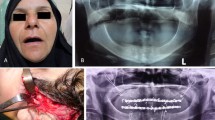Abstract
Recurrent dislocation of the mandibular condyle poses a difficult problem for affected patients. In the course of time, dislocations often become more frequent and more difficult to avoid. Even with good patient compliance, conservative treatment is often not sufficient. Operative procedures have also been described for the treatment of temporomandibular joint dislocation. However, these interventions are invasive, involving open arthrotomy with possible complications, and cannot safely guarantee a successful outcome. On the other hand, botulinum toxin injections into the lateral pterygoid muscles offer the option of a predictable and prolonged period without renewed dislocation. We present the results of this treatment carried out in 21 patients with recurrent temporomandibular joint dislocation. Four patients were treated following unsuccessful physical therapy and the use of occlusal splints. The remaining 17 patients were treated for a number of conditions resulting in dislocation, including some with senile dementia and mental impairment in whom compliance with conservative measures was poor or completely absent. Injections were given on a 3-month basis in order to have a sustained effect. Within the study period of 6 months to 3 years, only two of the 21 patients suffered further dislocation. There were no side effects recorded as a result of treatment.


Similar content being viewed by others
References
Borodic G, Johnson E, Goodnough M, Schantz E (1996) Botulinum toxin therapy, immunologic resistance, and problems with available materials. Neurology 46: 26–29
Borodic GE, Acquardo MA (2002) The use of botulinum toxin for the treatment of chronic facial pain. J Pain 3: 21–27
Daelen B, Thorwirth V, Koch A (1997) Treatment of recurrent dislocation of the temporomandibular joint with type A botulinum toxin. Int J Oral Maxillofac Surg 26: 458–460
Daelen B, Koch A, Thorwirth V (1998) Botulinumtoxinbehandlung der neurogenen Kiefergelenkluxation. Mund Kiefer GesichtsChir 2: 125–129
Freund B, Schwartz M, Symington IM (1999) The use of botulinum toxin for the treatment of temporomandibular disorders: preliminary findings. J Oral Maxillofac Surg 57: 916–921
Freund B, Schwartz M, Symington JM (2000) Botulinum toxin: new treatment for temporomandibular disorders. Br J Oral Maxillofac Surg 38: 466–471
Holmlund AB, Gynther GW, Kardel R, Axelsson SE (1999) Surgical treatment of temporomandibular joint luxation. Swed Dent J 23: 127–132
Moore AP, Wood GD (1997) Medical treatment of recurrent temporomandibular joint dislocation using botulinum toxin A. Br Dent J 183: 415–417
Naumann M, Hefter H, Heinen F (1999) Dysport. Klinische Anwendung von Botulinumtoxin. Uni-Med, Bremen
Porta M (2000) A comparative trial of botulinum toxin type A and methylprednisolone for the treatment of myofascial pain syndrome and pain from chronic muscle spasm. Pain 85: 101–105
Roser M, Cornelius CP, Topka H (1988) Neuerungen in der MKG-Chirurgie. Lokale Injektionsbehandlung mit Botulinumtoxin A. Mund Kiefer Gesichtschir 2: 121–124
Umstadt HE (2002) Botulinum toxin in craniomaxillofacial surgery. Mund Kiefer GesichtsChir 6: 236–240
Von Lindern JJ, Niederhagen B, Bergé S, Appel T, Reich RH (2000) Die Behandlung der muskulären Hyperaktivität der Kaumuskulatur mit Botulinumtoxin Typ A. Dtsch Zahnärztl Z 55: 26–29
Von Lindern JJ (2001) Type A botulinum toxin in the treatment of chronic facial pain associated with temporo-mandibular dysfunction. Acta Neurol Belg 101: 39–41
Zuber M, Sebald M, Bathien N, de Recondo J, Rondot P (1993) Botulinum antibodies in dystonic patients treated with type A botulinum toxin. Frequency and significance. Neurology 43: 1715–1718
Author information
Authors and Affiliations
Corresponding author
Rights and permissions
About this article
Cite this article
Ziegler, C.M., Haag, C. & Mühling, J. Treatment of recurrent temporomandibular joint dislocation with intramuscular botulinum toxin injection. Clin Oral Invest 7, 52–55 (2003). https://doi.org/10.1007/s00784-002-0187-y
Received:
Accepted:
Published:
Issue Date:
DOI: https://doi.org/10.1007/s00784-002-0187-y



